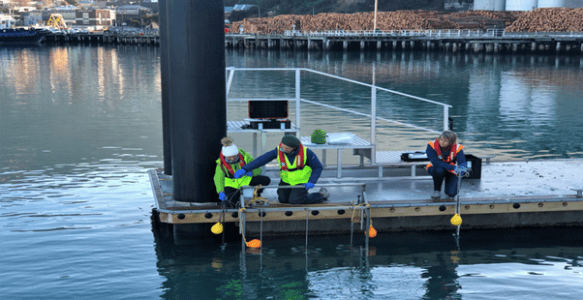Microplastics
Microplastics are found everywhere from table salt, drinking water and food, to the deep seas, far deserts and most remote mountains. While it’s not surprising to find plastics and microplastics in urban environments where they’re used every day, their appearance in uninhabited corners of the planet is deeply disturbing.
These tiny plastic fragments, many consisting of fibres less than 5mm wide, are lightweight enough to be carried on the wind: a new explanation for the widespread presence of these particles.
A new study published this year has found microplastics in soils collected from sand in the Kavir and Lut deserts of Iran, with an average abundance of about 0.02 microplastic particles per gram of sand. Globally, it has been estimated that up to 33.76 tonnes of atmospheric microplastic fibres can be generated in a year. And this amount is only going to grow as plastic production increases.
ESR scientist Dr Olga Pantos and Grant Northcott (Northcott Research Consultants) are co-leading a 5-year research study in New Zealand. The research aims to assess the extent of microplastic contamination and to advance research on the mediation of that threat. The research is being carried out in two primary case study sites in the Auckland and Nelson regions.

Microplastics are small plastic particles in the environment that come from a variety of sources, including cosmetics, clothing, and industrial processes. Microbeads are one example of microplastics, but they also can deteriorate from larger plastic pieces that have entered the oceans.

Microplastics eaten by larger marine animals will generally pass through their bodies. However, research does show that microplastics can be retained in the gut for extended periods where they may cause abrasion and damage to internal tissues. Nanoplastics can pass through the gut wall and travel to different parts of the body, such as the lungs and liver, where they can cause damage. Further research is required to understand the potential health implications from ingesting microplastics.

Recent media stories about microplastics, for instance the vast patch of garbage floating in the Pacific Ocean, have raised the profile of these particles. While the impact on the marine environment may be garnering the most attention at the moment, microplastics are found to be polluting a range of different ecosystems worldwide.
Due to the extensive use of plastics in our day-to-day lives, it is difficult to accurately measure the extent of microplastic pollution due to the cross-contamination of samples. ESR has therefore teamed up with the University of Canterbury to modify testing methods so that the characterisation and quantification of microplastics contamination in our environment is optimised. This involves ESR’s forensic specialists, who typically analyse physical evidence from crime scenes, applying their expertise to develop appropriate modifications to ensure that best practice is adopted.
References:
1.theconversation.com/plastic-everywhere
2. www.sciencelearn.org.nz/resources/2809-how-harmful-are-microplastics
3. ESR- science for communities: Optimising the process for microplastic analysis


 by
by